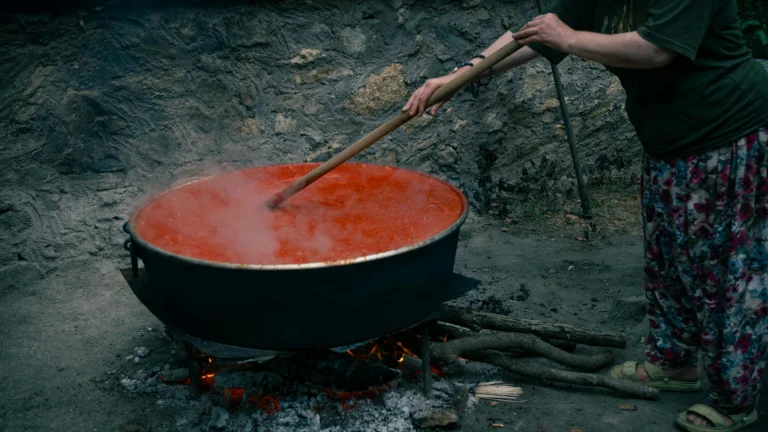Opening: A jar that tastes like long weekends
What you’ll make (at a glance)
-
Yield: about 4 pints (or 8 half-pints), depending on final thickness.
-
Texture: glossy, spoon-coating, pourable (ketchup-like).
-
Flavor profile: tomato-forward with a warm backbone of spice and gentle heat; easy to bump sweeter, smokier, or spicier after opening.
-
Best uses: grilled chicken, ribs, pulled pork, burgers, meatloaf glaze, baked beans, BBQ pizza base, roasted veg.
Why this canning method works
Gear You Need (simple + standard)
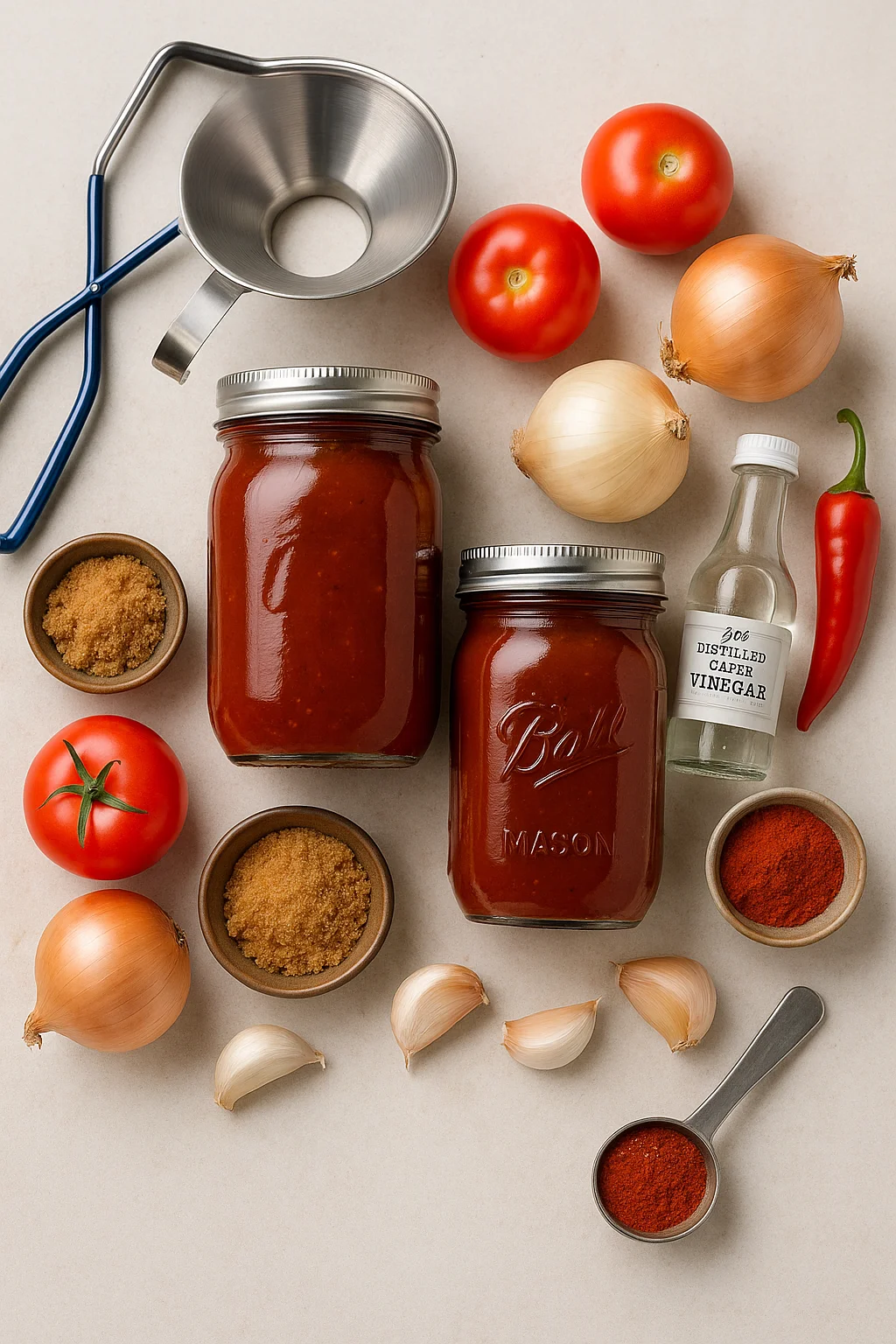
-
Boiling-water canner (or deep, lidded stockpot) with a rack
-
4 pint jars (or 8 half-pints) + new lids and bands
-
Jar lifter, canning funnel, bubble remover/headspace tool
-
Large nonreactive pot (stainless/enamel) for the sauce
-
Cheesecloth + kitchen twine (for peppercorn sachet)
-
Clean towels and a small bowl of vinegar (rim-wiping)
-
Food mill/sieve or immersion blender (for smooth texture)
Tested Ingredient List (do not alter acid amounts)
Stick to these quantities for safe acidity and proper heat-through. You can customize after opening.
| Ingredient | Amount | Prep notes |
|---|---|---|
| Red ripe tomatoes, peeled/cored/chopped | 4 quarts (≈24 large) | Blanch/peel for best texture |
| Celery, chopped | 2 cups | |
| Onions, chopped | 2 cups | |
| Sweet red or green peppers, chopped | 1½ cups (≈3 medium) | |
| Hot red peppers, cored & chopped | 2 | Wear gloves |
| Black peppercorns | 1 tsp | Tie in cheesecloth |
| Garlic | 2 cloves, crushed | |
| Brown sugar | 1 cup | |
| Dry mustard | 1 Tbsp | |
| Paprika | 1 Tbsp | |
| Canning/pickling salt | 1 Tbsp | |
| Hot pepper sauce | 1 tsp | |
| Cayenne | ⅛–1¼ tsp | To taste |
| Vinegar, 5% acidity | 1¼ cups | Apple cider or white |
Yield: about 4 pints (varies with simmer time and thickness).
Step-By-Step Method
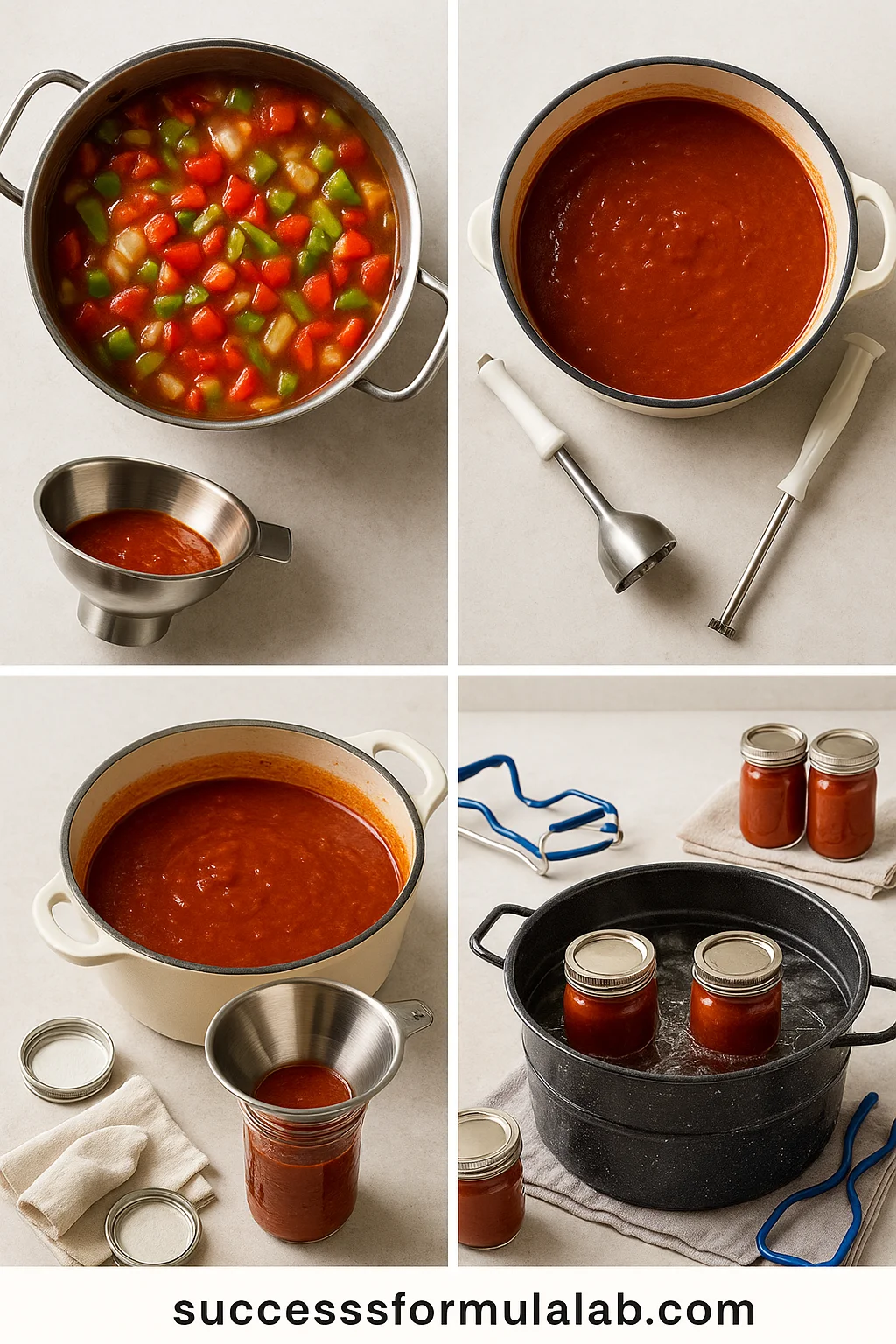
Prep the tomatoes and aromatics
-
Peel tomatoes: Score an “X,” blanch 30–60 seconds, shock in ice water, slip skins, core, and chop.
-
Chop veg: Measure celery, onions, sweet peppers, and hot peppers to the amounts above.
-
Tie peppercorns into a small cheesecloth sachet so you’ll remove them later.
Cook the base
-
Soften & simmer: In a large nonreactive pot, combine tomatoes, celery, onions, and both peppers. Bring to a gentle simmer until very soft (≈30 minutes), stirring to prevent sticking.
-
Purée: Pass the mixture through a food mill/sieve or blend smooth (careful with hot liquids). Return to the pot.
-
Reduce: Simmer the purée to about half its volume. Gentle, occasional bubbling is ideal—stir often to prevent scorching.
Season, balance, and finish
-
Spices in: Add the peppercorn sachet, brown sugar, dry mustard, paprika, canning salt, hot pepper sauce, and cayenne.
-
Acid in: Stir in 1¼ cups 5% vinegar. Don’t change this amount.
-
Final simmer: Cook gently until the sauce is ketchup-thick and glossy (≈60–120 minutes depending on pot size and heat). Remove the peppercorn sachet. Taste and adjust salt or heat within the written ranges only.
Prepare for hot-pack canning
-
Heat clean jars in hot water; keep them hot until filling.
-
Simmer lids according to manufacturer guidance.
-
Preheat canner: Load with hot water and a rack; you’ll need at least 1 inch of water above jar tops once boiling.
Fill, de-bubble, and set headspace
-
Ladle hot sauce into hot jars, leaving ½-inch headspace.
-
Slide a nonmetal tool down the sides to remove air bubbles.
-
Recheck headspace; adjust if needed.
-
Wipe rims with a vinegar-damp cloth; place lids; apply bands fingertip-tight.
Boiling-Water Processing Times (by elevation)
| Jar size | 0–1,000 ft | 1,001–3,000 ft | 3,001–6,000 ft | Above 6,000 ft |
|---|---|---|---|---|
| Hot-pack half-pints or pints | 20 min | 25 min | 30 min | 35 min |
Run the canner cleanly
-
Return to a full rolling boil before you start the timer.
-
Keep a steady boil for the entire process time.
-
When the timer ends, turn off heat, wait 5 minutes with the lid on, then remove jars upright to a towel.
-
Cool 12–24 hours, undisturbed. Check seals, wash, label, and store.
Safety Essentials (non-negotiables)
Acid is the backbone
-
Do not reduce the 5% vinegar or swap it for unknown-strength acids. The listed vinegar sets safe pH for water-bath processing.
Viscosity affects heat-through
-
Ultra-thick sauces can trap air and slow heat movement. Aim for pourable—like ketchup. If it’s too thick, thin with a little 5% vinegar before filling (staying within taste tolerance).
Ingredient swap rules (for the canning batch)
-
OK (modest): dried spices, a little more cayenne, small salt tweaks.
-
Not OK: large changes to vegetable quantities, fruit add-ins, or cutting vinegar. For fruit-heavy or low-acid experiments, make a fridge or freezer sauce—or use a separate tested recipe.
Storage, Shelf Life & Labeling
-
Store sealed jars cool, dark, and dry (10–21 °C / 50–70 °F is ideal).
-
For best quality, enjoy within one year; always refrigerate after opening and use within a few weeks.
-
Remove rings for storage (prevents rust and false seals) and label lids with date + batch so you can rotate your stash.
Troubleshooting Guide
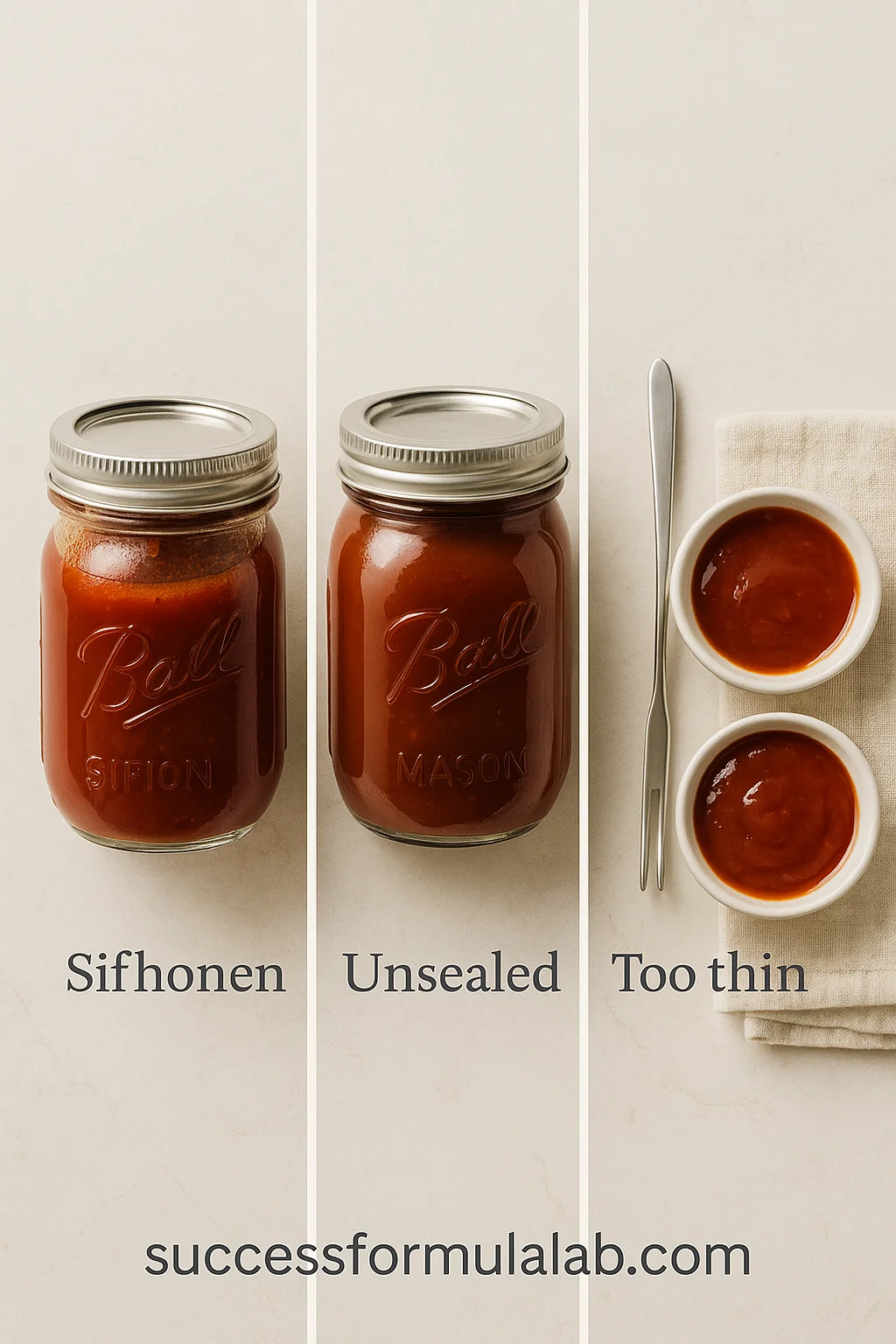
-
Siphoning (sauce leaked during processing): Often from rapid temperature changes or too little headspace. Next time, let jars rest 5 minutes in the canner after the burner is off; verify ½-inch headspace.
-
Lid didn’t seal: Refrigerate and use within a week, or reprocess within 24 hours with a fresh lid (heat sauce to hot-pack temp, new jar/lid, full process time).
-
Sauce too thin: Simmer longer next time; moisture content of tomatoes varies. For the current jar, just reduce on the stovetop after opening.
-
Too mild after opening: Stir in chipotle powder, extra hot sauce, or a pinch of cayenne to the portion you’re serving.
-
Too sweet after opening: Brighten with a splash of 5% vinegar or lemon to taste.
-
Dark layer at the top of the jar: Usually oxidation from excess headspace or extended storage; if sealed and processed correctly, quality issue only—stir in, or discard the top spoonful if flavor is off.
Flavor Variations (customize after opening)
Keep the canning batch as written; flavor-tune the opened jar for maximum flexibility.
Smoky-Sweet
-
Stir a pinch of smoked paprika or a drop of liquid smoke into the serving bowl. Finish with a teaspoon of molasses if you like gloss and depth.
Spicy & Bright
-
Swirl in extra hot sauce and a squeeze of lemon at the table. Add minced pickled jalapeños for texture.
Carolina-Lean
-
Add a splash of 5% vinegar to your warmed portion for sharp, tangy contrast—great with pulled pork.
Honey Finish
-
Stir in a spoon of honey after warming the sauce for a silky sheen and softened edges.
Printable Recipe Card
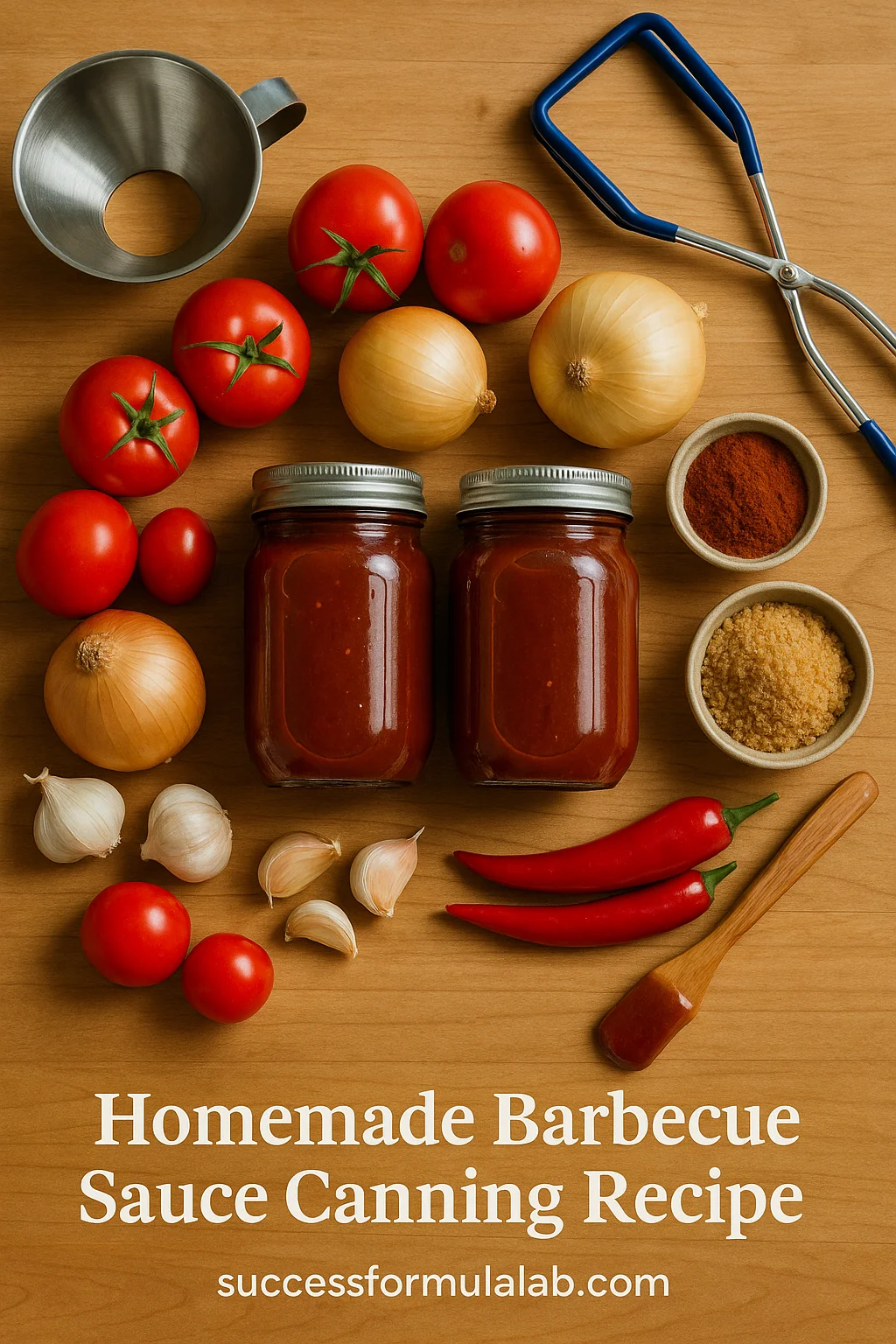
Homemade Barbecue Sauce Canning Recipe (Tested)
Ingredients (see table above for amounts)
Instructions (condensed for print)
-
Combine prepared tomatoes + veg; simmer soft. Purée and reduce by half.
-
Add peppercorn sachet, brown sugar, dry mustard, paprika, salt, hot sauce, cayenne, and 5% vinegar; simmer to ketchup-thick; remove sachet.
-
Hot-pack into hot jars, leaving ½-inch headspace; de-bubble; wipe rims; apply lids/bands fingertip-tight.
-
Process half-pints or pints at a full rolling boil: 20–35 minutes per the elevation table.
-
Turn off heat; rest 5 minutes; remove jars; cool 12–24 hours; check seals, wash, label, and store.
Notes
-
Do not thicken with flour/cornstarch before canning.
-
Keep vinegar amount as written.
-
Pints and half-pints share the same processing times for this formula (adjust by altitude).
Optional nutrition (per Tbsp, rough estimate)
≈ 20–25 kcal, 0g fat, 5–6g carbs, <1g fiber, ~120–160 mg sodium (varies with simmer and salt).
Frequently Asked Questions: Homemade Barbecue Sauce Canning Recipe
Can I reduce the vinegar in this Homemade Barbecue Sauce Canning Recipe?
No. The 1¼ cups of 5% vinegar is part of the safety design. Reducing or swapping to unknown-strength acids changes pH and can make the process unsafe.
Do pints and half-pints use different times?
For this tested formula, half-pints and pints use the same times. What changes is elevation: 20, 25, 30, or 35 minutes depending on your altitude (see the table above).
Can I pressure-can this sauce instead?
Use boiling-water canning for this formulation. Only use pressure canning if you have a separate, tested pressure-can timing and PSI for this exact recipe.
My sauce is very thick—still safe to can?
If it’s so thick that it barely pours, heat may move too slowly through the jar. Thin with a little 5% vinegar (keeping flavor balanced) or simmer a bit less before filling. Maintain ½-inch headspace and de-bubble thoroughly.
One jar didn’t seal—what now?
Refrigerate and use within a week, or reprocess within 24 hours using a new lid and full processing time. If you made large ingredient changes, skip reprocessing and use fresh.
How long do sealed jars last?
Quality is best within one year when stored cool, dark, and dry. After opening, refrigerate and use within a few weeks.
Can I add fruit (peach, pineapple) to the canning batch?
Not to this recipe. Fruit changes acidity and density. For fruit-forward BBQ, choose a separately tested fruit BBQ sauce or make a refrigerator/freezer version.
Can I sweeten with honey or a sugar substitute?
Keep the canning batch as written. After opening, honey is great; non-nutritive sweeteners are fine at serving time if you enjoy the taste.
Want a pantry that makes BBQ night effortless all year?
Build a shelf-stable lineup with The Lost Superfoods →
Recommended Resources
- The Lost Superfoods — field-tested, long-lasting pantry recipes that pair perfectly with your canned BBQ sauce.
- The Self-Sufficient Backyard — small-space garden layouts and kitchen workflows to keep ingredients and jars flowing through canning season.
Pro Tips for Consistent Results
-
Tomato choice matters: Meaty paste varieties reduce faster and scorch less.
-
Wide pot = faster reduction: More surface area means efficient evaporation and a brighter, fresher taste.
-
Stir the corners: Hot spots form where the pot curves; scrape with a silicone spatula regularly.
-
Headspace discipline: Measure ½-inch; rushing here causes many sealing and siphoning issues.
-
Rest in the canner 5 minutes: This simple pause reduces bubbling over and helps maintain liquid level.
-
Remove rings for storage: You’ll spot any seal failures quickly and avoid rust on the threads.

